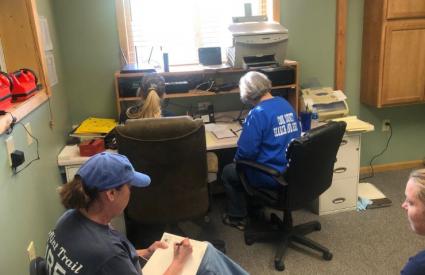How long does it take to evacuate the Gunflint Trail?
Emergency radios were busy this week as emergency responders sought to answer the question, "How long does it take to evacuate the cabin owners, lodges and forest visitors of the upper Gunflint Trail?"
The Gunflint Trail Volunteer Fire Department/EMS, in conjunction with the Cook County Sheriff’s Office and Dispatch, Emergency Management, Cook County Search & Rescue (SAR), and the U.S. Forest Service led an evacuation exercise at the end of the Gunflint Trail.
With command staff based out of Gunflint Fire Hall No. 3, located next to Seagull Lake, 40 participants visited each residence in the areas surrounding Saganaga and Seagull lakes providing evacuation instructions and education material. The volunteer responders travelled by vehicle, foot and boat.
Responders tested the time it took to cover dozens of the remote roads and neighborhoods, launching boats for water-access only notifications, and testing communication systems and supplies.
The training event was coordinated by GFTVD members. Firefighter Brianna Baumann served as incident commander. Firefighter and Rope Team Rescuer Ruth Baumann was operations chief and Firefighter/EMR/SAR Member Jessica Berg-Collman was communications lead, along with EMT and former EMS Chief Laura Popkes as the safety liaison.
With the exception of a small section of Sag Lake Trail, the crews were able to “evacuate” the entire area in about two hours. And that included a few secondary and time-consuming emergency scenarios.
“These exercises are vital not only to the local department for training, but a prime opportunity for inter-agency training and communication and to test our incident command systems,” said Sheriff Pat Eliasen. “It's also so beneficial for community members to receive face-to-face contact with local responders, receive evacuation notices and to start thinking about items they need to have ready to go in the event of a real evacuation like medications, ID, important paperwork, etc.”
Sheriff Eliasen added, “Kudos and sincere thanks to Gunflint Trail Fire Department, specifically the ladies who organized and led this complicated operation. Everyone did a fantastic job and I am proud to say, we have some awesome role models here.”
A check list for personal emergency/evacuation kits can be found here.
Next year, the GFTVFD will be focusing on the Gunflint Lake area for its annual drill.
Evacuation orders are issued by the Sheriff’s Office in accordance with the county’s overall Emergency Operations Plan. Cook County has experienced real-life evacuations from this remote area during wildfire events, the last time being the Ham Lake Fire in May 2007.
Tweet







